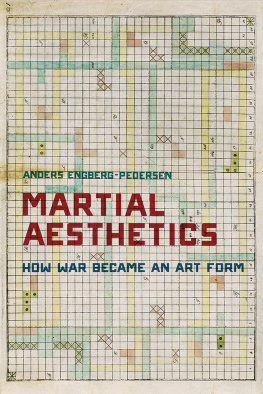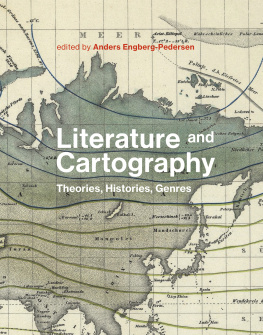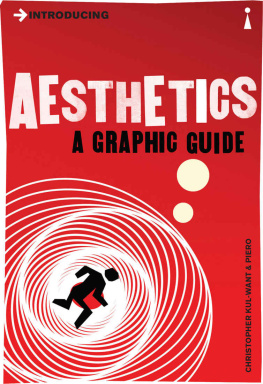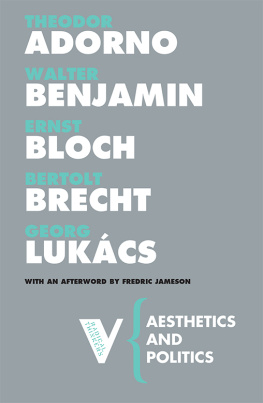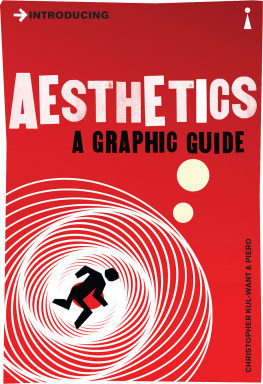MARTIAL AESTHETICS
How War Became an Art Form
Anders Engberg-Pedersen
STANFORD UNIVERSITY PRESS
Stanford, California
STANFORD UNIVERSITY PRESS
Stanford, California
2023 by the Board of Trustees of the Leland Stanford Junior University.
This work is licensed under a Creative Commons Attribution-NonCommercial-ShareAlike 4.0 license. To view a copy of the license, visit http://creativecommons.org/licenses. Suggested citation: Engberg-Pedersen, Anders. Martial Aesthetics: How War Became an Art Form.
Stanford, CA: Stanford University Press, 2023.

No part of this book may be reproduced or transmitted in any form or by any means, electronic or mechanical, including photocopying and recording, or in any information storage or retrieval system without the prior written permission of Stanford University Press.
Printed in the United States of America on acid-free, archival-quality paper
Cataloging-in-Publication Data available upon request.
Library of Congress Control Number: 2022019748
ISBN: 9780804799942 (paper), 9781503634862 (ebook)
Cover art: Playing board of Hellwigs wargame.
Source: Johann Christian Ludwig Hellwig, Das Kriegsspiel (Braunschweig, 1803).
Cover design: Jason Anscomb
In memory of Mette Teilmann Nielsen
April 12, 1979, RoskildeJanuary 17, 2014, Kabul
It is futile, even wrong, to try to turn a blind eye to the brutality of war because of unwillingness to accept its true nature.
Carl von Clausewitz
CONTENTS
PREFACE
The twenty-first century has witnessed a pervasive militarization of aesthetics. Western military institutions have co-opted the creative worldmaking of art and aesthetics and merged it with the destructive forces of warfare. This unusual merger has taken place both in the material domain of media and technologies and in the theoretical domain of military ideas and doctrines. Artificial aesthetic worlds such as 3D terrain simulations and synthetic training environments pervade contemporary war efforts, and thinkers in several leading Western militaries have adopted key aesthetic concepts from the discourse on design. Today, military institutions form an unexpected avant-garde in both senses of the term: as the military front-runner for a new operational aesthetics.
What are we to make of this curious imbrication of two phenomena that seemingly belong to entirely different realms and orders of human experience? How is the brutal business of war and the disastrous effects it has on peoples lives tied up with artistry, artifacts, and creative world-making? And when did military thinkers begin to speak the language of art and aesthetics? Martial Aesthetics: How War Became an Art Form examines the origins of this at once strange and sinister phenomenon. It shows that the creative warfare of the twenty-first century is merely the most recent moment in a historical development that began much longer ago. Indeed, the emergence of martial aesthetics harkens back to a series of inventions, ideas, and debates in the eighteenth and early nineteenth centuries. Already then, military thinkers and inventors adopted ideas from the field of aesthetics about the nature, purpose, and force of art and retooled them into innovative military technologies and a new theory that conceptualized war not merely as a practical art but as an aesthetic art form. Adopting an approach that is simultaneously historical and theoretical, the book shows how early war media (from star charts and horoscopes to the Prussian Kriegsspiel, or wargame) and military discourses (from Kepler to Clausewitz) were entangled with classical ideas in philosophy and aesthetic theory (by thinkers such as Leibniz, Baumgarten, Kant, and Schiller), in order to trace the emergence of martial aesthetics. Against this historical background, the book also presents a new theoretical frame for war in the twenty-first century. The book argues that, as counterintuitive as it may seem, we need to acknowledge the constitutive role of aesthetics in war. Inventing and shaping desired futures like works of art, the military has long sought to frame war as a creative and artistic activity. But the book also points to the perils of this endeavor. Martial aesthetics not only designates a set of inventions and ideas that military institutions have produced over the past 250 years. It also signifies the systematic erasure of brutality, suffering, and death, and the troubling transfiguration of collective violence into the free and noble endeavor of artthe enchantment of war as an art form.
INTRODUCTION
Creative Warfare
The first time Watson died, he was on a gently sloping hill surrounded by hazy mountains. It was back in October 2009, and his fellow soldiers from the US Marine Corps First Tank Battalion Scout Platoon were driving their tank across the desert landscape. A few minutes earlier, a helicopter had taken out a tank far ahead in the distance, and the squad was expecting a violent encounter with enemy forces. Veering off the paved road that carved through the valley, the driver pushed up the hillside. As they reached the top, the vista that opened below them under the gray skies revealed numerous insurgents, who soon began to shoot. Perched on top of the tank, Watson, the gunner, returned fire. As the smoke from his crackling quick-fire rounds began to lift, the scene became clear. They were all dead. In the distance, on the other side of the road, two new insurgents unexpectedly appeared. Another tank to Watsons left immediately eliminated them. But as Watson would soon realize, the danger wasnt over. The turret of the armored vehicle offered some protection, but out in the open he remained highly exposed. Two dry, barely audible sounds suddenly clicked in quick succession. The second shot hit Watson and sent him tumbling to the ground. He was killed on the spot. But it wasnt necessarily the last time he would die that day.
Using the training platform Virtual Battle Space 2 (VBS2), Watson had been engaged in a simulation designed to provide soldiers with an immersive virtual experience of war before going into actual combat. Safely ensconced inside the Marine Corps base in Twentynine Palms, California, Watson was located inside the Battle Simulation Center, where he drove along a virtual terrain based on actual cartographic data from a potential combat zone. Playing a serious game, Watson and his comrades were immersed in a half-imagined, half-real world where a series of exchanges and transfers took place between the ludic events in VBS2 and the minds of the scout platoon of the First Tank Battalion.
This highly dramatic and entirely uneventful scene itself unfolds inside an art installation by the German documentarist Harun Farocki. Serious Games IIV is the title of a series of video artworks first featured at the biennale in Sao Paolo in 2010 and since shown in art galleries across the world. Displayed on four separate screens, they examine the complex apparatus that subtends and organizes such simulations. As Watson and the other platoon members play the game, an instructor concurrently builds the simulated world they move around in and creates the dangers they are exposed to. Also visible to the audience, the instructor selects different types of explosive devices and templates of enemies from a drop-down menu and places them at strategic locations with a few mouse clicks.

